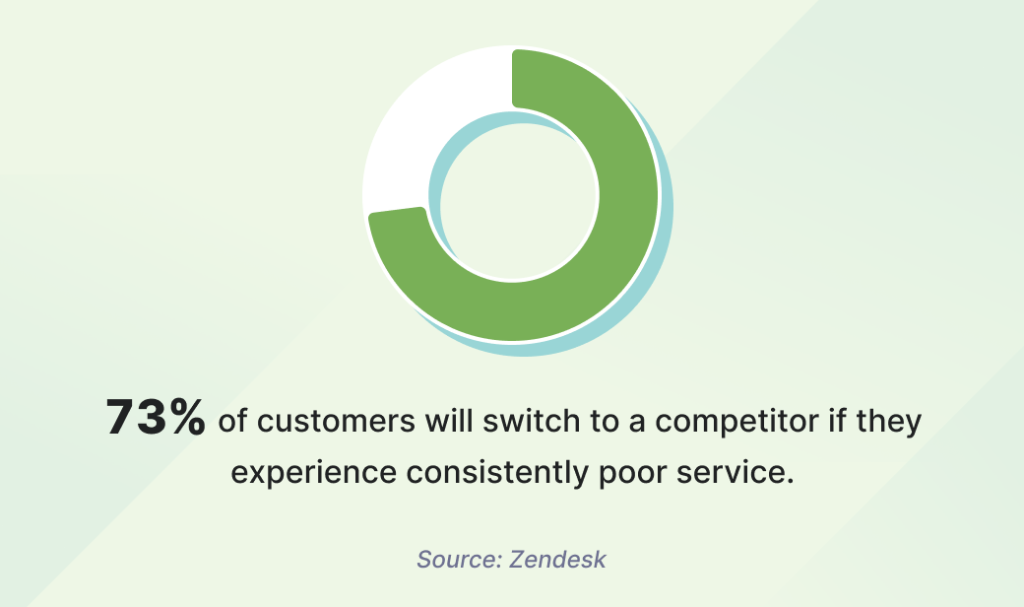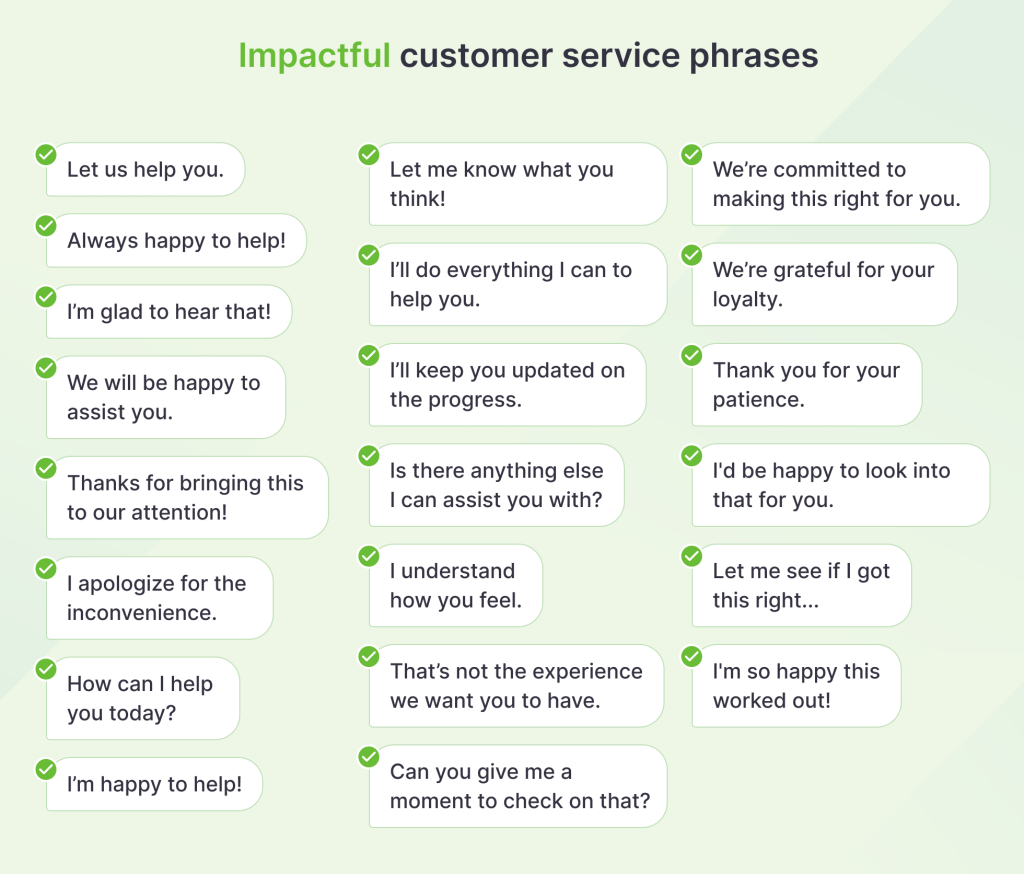
Powerful customer service phrases can help you improve client interactions and ensure that your customers feel like they can always rely on your services.
The phrases we included convey empathy and understanding, instilling trust in the customer. This results in improved satisfaction and retention. 73% of customers will choose a competitor after facing repeated bad service, stressing the expensive consequences of poor customer care.

Below are 20 phrases our customer support team found work best when serving clients. We also included 10 you should avoid and some extra tips on approaching different customer service scenarios.
Professional words for customer service
Here are the most effective power words for customer service you should use to ensure excellent customer support for different scenarios:

1. “Thanks for bringing this to our attention!”
This phrase acknowledges the customer’s concerns and shows appreciation for how they were brought forward.
It sets a positive tone for the interaction and shows that the company is taking the customer’s issue seriously.
2. “I apologize for the inconvenience.”
This phrase shows empathy and a willingness by the company’s side to take responsibility for any inconvenience the customer may have experienced. It helps to defuse a potentially negative situation and shows interest in solving the issue.
3. “How can I help you today?”
This phrase shows that the customer service representative is eager to assist the customer and is focused on providing a positive experience. It also opens the conversation and allows the customer to explain their issue or request.
🎬 Scenario: Initial contact with a customer or addressing a concern when a customer expresses confusion or frustration.
4. “Is there anything else I can assist you with?”
This phrase shows that the customer service representative is eager to go above and beyond to ensure the customer’s satisfaction. It also allows the customer to bring up any other issues or concerns they may have.
5. “I understand how you feel.”
This phrase will reassure the customer that they are heard and understood, which is important for building trust and rapport. It also shows that the customer service representative is empathetic and willing to put themselves in the customer’s shoes.
6. “I’m happy to help!”
This power phrase shows empathy and enthusiasm towards the customer’s issue and sets a clear purpose for the interaction. You can also try using similar phrases like “Glad to help,” “Happy to be of service,” or “Happy to assist.”
7. “I’d be happy to look into that for you.”
This phrase demonstrates a willingness to help and take ownership of the issue.
8. “Let me see if I got this right…”
This confirms the customer’s issue and ensures that the agent in charge fully understands before proceeding with a solution.
9. “That’s not the experience we want you to have.”
This is how you acknowledge the customer’s frustration and reinforce the idea that the company wants to deliver a positive experience.
10. “Can you give me a moment to check on that?”
This power phrase for support works best when a customer asks a complex question, and the agent needs to check his/her resources before answering just to be fully sure of the answer.
11. “Let us help you.”
This phrase conveys support and establishes a collaborative approach with the customer.
12. “Always happy to help!”
This phrase is typically used at the end of the interaction to leave a positive, lasting impression and reassure the customer that they can always rely on your support.
13. “I’m glad to hear that!”
This reply expresses genuine excitement for positive feedback, making the customer’s experience more enjoyable.
14. “We will be happy to assist you.”
This phrase communicates a strong willingness to help. It uses positive words for customer service to reassure the customer that their concerns will be addressed.
15. “Let me know what you think!”
This phrase shows gratitude and acknowledges the customer’s role in improving the service or product.
16. “I’ll do everything I can to help you.”
This phrase conveys determination to fix the problem and shows the customer that you’ll exceed their expectations.
17. “I’ll keep you updated on the progress.”
This phrase uses positive language in customer service to ensure transparency and keep the customer well-informed.
18. “Thank you for your patience.”
This phrase shows gratitude for the customer’s understanding during a longer process or wait time.
19. “We’re committed to making this right for you.”
This phrase emphasizes dedication to fixing the issue.
20. “We’re grateful for your loyalty.”
This phrase shows appreciation for the customer’s ongoing trust and loyalty.
Customer service phrases to avoid
Every customer service agent should stay away from phrases such as these:

1. “That’s just the way it is.”
This phrase can come across as dismissive and unsympathetic. It can also make the customer feel like their concerns are not being taken seriously.
Try this instead:
2. “I’m sorry, but…”
This seems insincere, as the apology is followed by a justification or excuse.
Try this instead:
3. “I don’t know.”
This response is not helpful and can make the customer feel like the customer service representative is not willing to assist them.
Try this instead:
4. “That’s not my problem.”
Service agents who use this phrase will seem uncooperative and can make the customer feel like the company is dismissing the problem altogether.
Try this instead:
5. “Please calm down!”
The confrontational tone of this line can make the customer feel like they are being attacked, and it can also damage trust and rapport.
Try this instead:
6. “It works for me.”
This type of response invalidates the customer’s problem without providing a solution. Variables on the client side might make it difficult for the support agent to reproduce the same issue.
The ideal approach in this scenario would be for the agent to request extra information. Be proactive, refrain from repeating questions, and try to provide multiple solutions.
Try this instead:
7. “Unfortunately, we don’t offer that.”
This phrase can sound negative and limit the customer’s sense of possibility. Instead of focusing on what is not available, emphasize what options or alternatives are available to them.
“Regrettably’ is often used as another word for ‘unfortunately’ in customer service to convey that a desired option is unavailable.
Try this instead:
8. “You’re wrong.”
Telling a customer they are wrong can come off as confrontational and damage rapport. You should always use language that encourages understanding and problem-solving.
Try this instead:
9. “That’s not covered by our policy.”
This phrase can seem rigid and unhelpful, leaving the customer feeling frustrated and unsupported. Don’t focus on what isn’t possible and emphasize the steps you can take.
Try this instead:
10. “There’s nothing I can do.”
This phrase conveys helplessness and can leave the customer feeling unsupported. Try to reassure them that you will do your best to find a solution.
Try this instead:
Responses for common support scenarios
Here are various customer service scenarios that include key support phrases.
1. Acknowledging the customer’s issue
This is an example of how to professionally address customer issues if you’re working in the software as a service (SaaS) industry.
Customer: “I’ve been having a hard time using the [feature] on your platform. Can you help me troubleshoot the issue?”
Agent: “Thank you for reaching out to us. We’re sorry to hear that you’re experiencing difficulty with our platform.
We’re here to help and want to ensure that you get the most value from our service. Can you please provide me with more details about the issue you’re facing and also share your account information so I can investigate and assist you in resolving the problem?”
2. Thanking the customer for their feedback
Most guides tell you to thank customers for their feedback. But the truth is most feedback never gets actioned. Try replacing regular “thank you for your feedback” messages with something more authentic that lets the customer know you are forwarding their information to the relevant people.
3. Asking the customer to elaborate
Customers don’t always reach out to the right department with an issue. Asking them to elaborate is perfectly fine and makes it easier to reroute them to the right department.
4. Apologizing for a mistake on your end
When your company makes a mistake, it’s crucial to acknowledge it with sincerity and offer a solution. An honest apology reassures the customers that their concerns will be addressed quickly.
5. Saying that you understand why they’re frustrated
Acknowledging a customer’s frustration is an essential part of demonstrating empathy and showing that their concerns matter. Here’s how to approach this.
6. Asking if the customer has any other questions
Once you’ve addressed the problem, it’s always a good idea to confirm that the customer is fully satisfied. Offering to answer any additional questions highlights your dedication to exceptional customer service.
7. Describing the solution in detail
Sometimes customers will reach out with questions about your product or service. It’s a great idea to generate a template response that you can quickly personalize to answer their inquiries in a timely manner. Here’s an example you can use:
Agent: “We have a wide range of products that are perfect for your needs. Our retail solution includes [relevant products] that are designed to [address customer pain points].
Whether you’re looking for a [product category] at an affordable price or you need a more advanced range with additional features, we are happy to customize your offer.
If you have any questions or concerns, please let us know, and we’ll be happy to assist you.”
8. Telling customers what to do next
When a customer finishes a key task, offering detailed guidance for the next steps ensures that everything goes smoothly. Giving precise directions helps prevent misunderstandings and sets clear expectations.
Agent: “Congratulations on signing up for our free trial! We’re excited to have you on board and look forward to helping you get started.
Please check your email for a confirmation message that includes instructions on accessing your account.
I just wanted to quickly check in and recommend some next steps for you:
- [Describe action 1]
- [Describe action 2]
- [Describe action 3]
You can also find a step-by-step guide on our website. If you have any questions or need further assistance, please don’t hesitate to contact us.”
9. Sending an apology email when you make a mistake
When things go wrong, it’s essential to admit the mistake and apologize to the customer immediately. A well-crafted apology email should express regret and show that you’re committed to fixing the issue.

“Dear [Customer name],
We are sorry for the delay in processing your order and for any inconvenience this may have caused.
We understand how frustrating this can be, and we take full responsibility for the error. To make things right, we have sent the parcel using express shipping services and included a special gift we hope you’ll enjoy.
Thank you for choosing our service and for giving us the opportunity to make things right.
Best regards,
[Your name]
[Your position]
[Your company name]”
10. Checking up with your customer after a long time
Checking in with customers through a follow-up message is a great way to learn about their experiences, gather their thoughts, and remind them of your continuous support.
11. Asking for customer feedback
Knowing how to ask customers for feedback properly creates an open line of communication that invites honest opinions and suggestions for improvement.
“Hello [Customer name]!
How was your overall experience with our product?
Was there anything that exceeded your expectations or anything that we could improve on?
Please rate your experience on a scale from 1 to 10.
Your opinion will be used to upgrade our product, so it meets customer expectations and serves clients even better. Thank you for your time and for choosing our company.”
12. Keeping clients informed about updates
Regular communication helps the clients feel valued and aware of the improvement we’re making based on their feedback.
“Hello [Customer name],
I wanted to reach out to you regarding the additional feature you requested for our [product/service]. I’m happy to inform you that we have implemented that feature, and it’s now available for use. Is there anything else that you would like to see added to the product?
As a token of appreciation, we would like to offer you a complimentary trial of this feature. If you’re interested, please let us know, and we’ll be happy to set that up for you.”
13. Sending updates about service maintenance disruptions
Keeping your customers informed about scheduled maintenance is essential for transparency and trust.
“Dear [Customer name],
I apologize for the inconvenience this may cause, but we will be performing scheduled maintenance on our service on [date]. During this time, our service will be unavailable for approximately [time frame].
We understand that this may cause a disruption in your service, and apologize for any inconvenience. If you have any further concerns or questions, please do not hesitate to reach out to our customer service team.”
Improve your customer service communication
Using key customer service phrases can significantly improve customer communication and ultimately enhance their overall experience with your brand. These phrases can be used to show empathy, provide reassurance, and gather valuable feedback.
By using a combination of active listening, clear language, and a focus on the customer’s needs, support teams can effectively address customer concerns and provide exceptional service. Implement these phrases into daily communication to increase customer satisfaction and retention.
Related articles
SMS, MMS, and text messages: What are the differences
SMS has been in our lives for decades now, but the o...
Workplace collaboration: Our secrets to more productive teams
Seamless collaboration in the workplace is a game-ch...
Mobile live chat and real-time customer service
Playing guinea pig for your company’s new software r...
7 Easy ways to send texts from your computer
Whether you’re looking to check in with a frie...
6 Steps to boosting referrals by reaching out directly
There are numerous reasons why asking for a referral...




